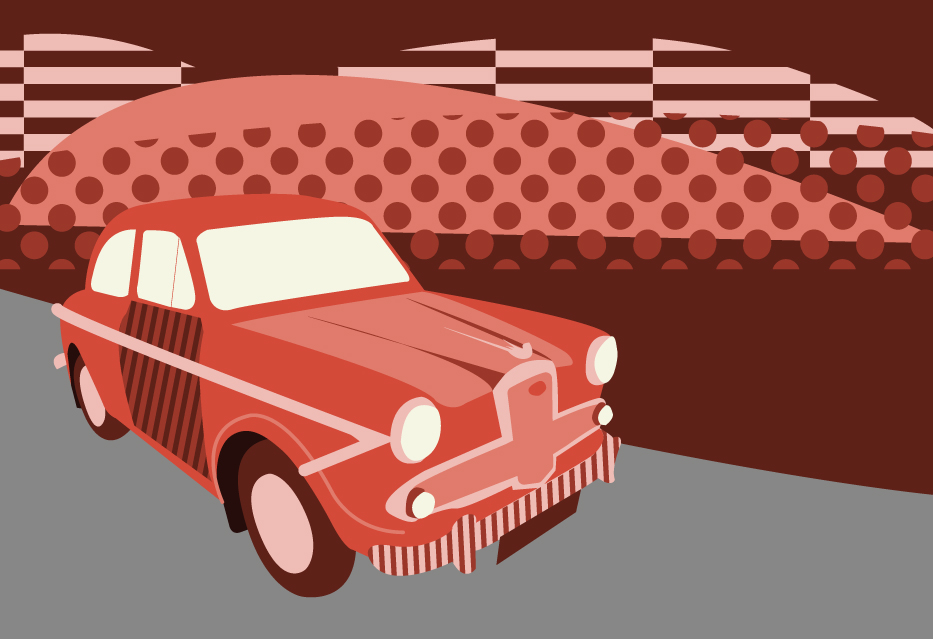It was the little family car that morphed into arguably the best hot hatch of the golden era of pocket rockets.
The Peugeot 205GTI was declared “car of the decade” by CAR magazine in 1990, and the greatest car ever tested by What Car? in 2020.
How did Peugeot, a company not known for excitement, produce a sporting icon?
Although Peugeot had entered the supermini market with the 104 in 1973, until the 205 arrived it was best-known for its large saloons like the 504 and 505.
In the late ‘70s though, the company purchased Chrysler’s European car divisions Simca and the former Rootes Group, both well-versed in small car production, and plans were put in place for a fresh assault on the growing small hatch market.
Designed in-house, and not by Pininfarina as is often thought, the 205 was launched in February 1983, only pipped to the European Car of the Year award by the Fiat Uno.
It shone in a crowded field of emerging superminis, competing not only with the Uno, but also the new Vauxhall Nova, Austin Metro and Nissan Micra, and the second generation VW Polo and Ford Fiesta.
The styling proved so successful it was echoed on every subsequent Peugeot model until the mid-90s, and was never updated in the car’s 15-year production run.
By the end of its run, the 205 had become Peugeot’s best-selling car in the UK, and the GTI had given the company a huge image boost that would filter through to sales of other models, not least the Escort-sized 309.
Enter the GTI
The Peugeot 205 GTI made an immediate impact when it arrived in the spring of 1984, its body side mouldings, deeper front spoiler, drilled alloy wheels and red trim marking it out from the standard model.

Rear quarter light styling took its cues from the Group B-busting homologation special, the turbo-charged, 200bhp T16, with distinctive 1.6 GTI lettering around the fuel filler cap.

A Bosch L-Jetronic fuel-injected version of the 1580cc power unit shared with the 305GT and Citroen BX16 produced 104bhp and maximum torque of 99lb ft at 4000rpm.
Good numbers, but not best in class. Seemingly nothing special.
What was special, however, was the way that power was delivered, the phenomenal roadholding, and the go-kart-like steering.
When Motor tested a 205 GTI in May 1984, they asked if it was “the true successor to the original VW Golf GTi”.
And you can see why. Weighing just 900kg, the Peugeot shared a similar footprint with the first generation Golf, which had grown in size and weight in mark 2 form (and would continue to do so).
The magazine said the newcomer had incorporated “many lessons learned from its older classmates, but offers more excitement – for Peugeot have gone all-out for a no-compromise road burner. It demands to be taken seriously”.
Exhilarating experience
More than £1,500 cheaper than the latest Golf GTi, it also undercut the larger Astra GTE and Escort XR3i, offering similar performance but a more exhilarating experience.
The Peugeot delivered its power smoothly and effortlessly, responding snappily to the merest touch of the light throttle.
It made the GTI a delight to drive briskly, but called for a delicate touch at low speeds in congested traffic.

Capable of hitting 60mph in 8.7 seconds, the Peugeot was capable of a remarkable 118mph, leaving larger-engined tearaways like the Golf GTi and Astra GTE gasping for breath to keep up.
Motor described the gear-shift as “superb”, the roadholding and handling as “phenomenal” and, overall, a car that “manages to combine the appeal and charisma of the old Mini Cooper with the sweetness of the first Golf GTi”.
“Fast and fun, the 205 GTI lives up to its promise of affordable excitement,” it concluded. “It matches the performance of considerable more expensive rivals and runs circles around similarly priced hotshots.”
The only black mark was for the car’s rock hard, uncompromising suspension.
What Car? agreed, noting that the firm ride could prove “tiring on a long journey”, but in all other respects it blew the new XR2 and the MG Metro Turbo out of the water in a three-way test in August 1984.
Adrian Flux Classic Car Insurance
Peugeot had “worked magic” with the previously uninspiring 1580cc engine.
“The low gearing and urgent engine note contribute to the feeling that this car begs to be driven fast everywhere, and the excellent low down torque means there is instant acceleration available,” the magazine wrote.
“The Peugeot is quite simply by far the most fun to drive, it looks every inch the part, and there are few areas in which the boy racer style has led to a compromise in the practical qualities of the ordinary 205.”
The racing driver’s view
By 1986, the GTI had gained an extra 10hp, thanks to a modified cylinder head, bigger valves, slightly hotter cam timing and increased valve lift.
Motor magazine asked Martin Brundle, competing for Tyrrell in Formula One at the time, to put the upgraded car through its paces in July 1986.
Despite noting “something missing in the build quality of all French cars”, the King’s Lynn-born racer was full of praise for the Peugeot.

“My first drive was an eye-opener,” he wrote. “I put the car through its paces around a 90 degree corner for photographer Rowe and was astonished at how well it coped. Without going silly I couldn’t make the car feel dramatic at all.
“It’s like a gymnast – strong, balanced yet very supple. I thoroughly enjoyed driving this car. On demanding UK roads, I suspect there’s not much at the price that would cover the miles as quickly and enjoyably.”
He thought the car could comfortably handle an increase in power from 115bhp to 130bhp, which it would the following year with the introduction of the 1.9-litre engine.
Indeed, there were already signs that the 205 could do with a power boost when the 1.6 lined up against a Renault 5 GT Turbo and a Honda CRX for CAR magazine’s triple-header in August 1986.
All of the cars could accelerate from standstill to 100mph in a time that would once not have disgraced an Aston Martin, and all could lap a racing circuit such as Donington in a time that would be on a par with a competently driven club-race Ferrari. And all for around £8,000.
But the Peugeot was at least a second slower to 60mph than the other two, and its French rival took the magazine’s plaudits for its electric performance and unrivalled handling.
Not that CAR’s reviewers had a bad word to say about the 205.
“For sheer harmony of shape, there’s no matching the Peugeot 205GTI,” it wrote. “In a couple of decades’ time we’ll be looking back on this car as one of the best efforts of the ‘80s.
Like our illustration of the Peugeot 205GTI at the beginning of the article?
Download a free high-quality poster version here.
A beautiful and excellent car
“The Peugeot remains a beautiful and excellent car. It is inspiring to drive, re-sells well and seems assured of an honourable place in history.”
Motor also pitted the 205 against the Renault, but replaced the Honda with the Fiat Uno Turbo i.e. in a battle to find the best “off-the-peg shoebox supercar” that could “embarrass a Sierra Cosworth or even a Testarossa if the road was sufficiently twisty”.
While acknowledging that the turbo-charged 5 “is so potent that, regardless of anything else, it’s going to swing things the Renault’s way with many buyers”, it came down on the side of the normally aspirated Peugeot.
“Squeeze the Peugeot’s super-responsive throttle, no matter what the revs, and you’re away, cleanly, ‘laglessly’, sweetly,” it wrote.
“It is not as exciting as either of the turbos but in terms of usable performance it gives nothing away in journey times. There’s so much that’s right, and so little wrong. Family hatchbacks don’t come any better than this.”
Pininfarina works its magic
The belief that Pininfarina was responsible for the 205’s styling probably came about because Peugeot did turn to the Italians for the drop-top CTI.
Bare shells were shipped to Italy for the conversion, which added about 200lb of stiffening to the car, making it a little slower off the mark than the GTI.
Pininfarina did a fine job, the neat hood barely intruding into the luggage space when folded down, and endowing the car “with all the characteristics of a saloon, with good visibility and no flapping or drumming”, according to MotorSport magazine.

It joined the XR3i, Astra GTE and Golf GTi (still in mark 1 form) in a rag-top group test for CAR magazine in July 1988, where it was the cheapest on offer, and the best equipped with electric windows, central locking and a stereo…
There’s no getting away from the fact that the French car was flimsier than its rivals, but it was also by far the quickest, the liveliest, and the most peppy.
“None of the others can compete with the Peugeot’s agility, speed and sheer entertainment value,” said CAR.
“Jump into the 205 after driving the Golf – the next best – and you’re instantly aware that this is a lighter, nimbler, more dynamic piece of machinery.
“On any sort of day, sunny or grey, you’d pick up the CTI’s keys first.”
More power, more fun
As the ‘80s wore on, the hot hatch arms race intensified, and Peugeot reacted with a beefed-up, big valve 1.9-litre, 130bhp engine, which joined rather than replaced the 1.6.
Differences included half leather seats, disc brakes all round, larger, 15in diameter, wheels, thicker anti-roll bars, and revised spring and damper rates.

Its improved 0-60mph time of 7.8 seconds was only bettered by the Renault 5 GT Turbo, a true hooligan.
Autocar wrote in January 1987 that the new car produced “smooth, clean power right the way through the rev range, which equates to a really noticeable improvement in responsiveness – and that for a car which was already noted for its responsiveness”.
The ultra-light throttle still presented problems in slow-moving traffic, with only a slight flexing of the big toe enough to send the car surging forward. Kangaroo hops were not uncommon until drivers had mastered a featherlight touch.
The 205 GTI was already a driver’s car, but the greater power took it to a new level, “as long as you like very powerful front-wheel-drive machines – for it accelerates, handles and brakes with the best in this class”.
Autocar predicted that the seat-of-the-pants 1.9 “is not a car which will ever appeal to the mass market”.
It certainly wasn’t bought in large numbers as a family car, but it was a hit among the younger generation, while they could still afford the insurance premiums at least.
While the 1.9-engined car proved to be a Golf GTi and Astra GTE-beater, the 1.6 GTI was still around to take on the smaller hot hatches that were natural competitors for the pint-sized Peugeot.
One of them was the brand new Fiesta XR2i, closely matched in power with its 110bhp 1.6-litre engine.
So here we have a six-year-old car against a brand new model. Surely there should only be one winner?
Not so, according to Autocar & Motor, which tested the pair in October 1989 and noted how no improvements to the Peugeot had been necessary since its launch: “The car’s shape is still fresh, adornment is minimal and the effect superb.”
The 205 is only marginally quicker to 60mph, but the difference in engines beyond that is stark.
“As the pace goes up the enjoyment of using the (Ford) CVH engine goes down,” the magazine wrote. “At 4000rpm, just when the Peugeot’s XU engine is hitting its stride, the Ford’s motor becomes harsh and thrashy.”
The 205 outscores the Fiesta in ride, handling and gear change: “When the Peugeot feels crisp and responsive, the Ford feels vague and dull-witted.
“Few 205 GTI owners will be trading in their cars for the XR2i. On the road, the Peugeot is on a higher plane.”
Hot hatch king
Every now and then, a magazine will group together a huge assembly of cars and a batch of journalists to find out once and for all which is the best.
CAR undertook such an exercise for its September 1990 issue, ostensibly to see if the relaunched Mini Cooper could live with the modern hot hatch, testing 10 cars over a route in North Yorkshire to find out which was the most fun.
The contenders, alongside the Mini and 1.6 205 GTI, were: VW Golf GTi 8v, Vauxhall Astra GTE 16v, Alfa Romeo 33 16V, Citroen AX GT, Fiat Uno Turbo, Ford Fiesta RS Turbo, Mazda 323F GT, Metro GTi 16v, and Renault 5 GT Turbo.
Of the six testers, only one placed the 205 in first place, but four placed it second overall and the other third.
In conclusion, the magazine declared “a comfortable victory for the 205 GTI, a car that everybody liked”.
Even after a decade in production, the unchanged 205 GTI was as good as the day it was launched, a roughneck road racer with an intoxicating zest, a hyperactive upstart that could whizz around the countryside quicker than almost anything on the road.
Sadly, this made it an increasing target for thieves and joyriders, and insurance premiums soared beyond the reach of the very people for whom this type of car was made.
The small upside, for anyone who could afford the insurance, was that, as Quentin Wilson said in 1993, “used prices have fallen like a Steinway from a tower block”.
Describing the car, even then, as a “design classic”, he recounted how “getting a cover note for a GTI has become as easy as insuring a building in Beirut”.
“We got a quote of £6,000 for an 18-year-old on a 1.9.” Ouch.
Increasingly stringent emissions regulations also played a part in the 205 GTI’s demise, the 1.6 dropped after nine years in 1992, with the 1.9 living on for another couple of years thanks to a catalytic converter, which dropped power slightly to 122bhp.
A timeless classic
Out of production for more than 25 years, the Peugeot 205 GTI remains a benchmark against which the modern hot hatch is measured.
Very few cars introduced in the 1980s look this good today, and Peugeot has never quite managed to reproduce the sort of no-holds-barred thrills of this tiny supercar.

Used as a classic car, insurance will no longer break the bank, and the best 1.9 cars fetch in excess of £15,000.
Testament to the car’s brilliance was summed up by journalist Andrew Frankel, writing in MotorSport in 2013.
He was looking for a cheap and fun old car to replace his under-utilised old Porsche 911 and, after mulling over a BMW 2002, early Golf GTi and a “very tempting” Alfa GTV6, it was overseeing a world cup of hot hatches that made up his mind.
“In one corner sat the Lancia Delta Integrale Evoluzione 2, in the other the rather more humble Peugeot 205 GTI,” he wrote.
“Lacking the Lancia’s power, pedigree, four-wheel drive, turbo, multi-valve head and competition pedigree I expected the Peugeot to compete only for value for money. I have rarely been more wrong. The fact is that after a couple of hours skidding around a test track it was the little Peugeot which steered better, changed gear and direction better and was, in short, the more fun to drive.”
So he bought one, a 1990 1.9-litre, in which he spent “the Christmas period dodging the floods and welding a smile to my face”.
And that’s the joy of the Peugeot 205 GTI – a car that looks great, goes like stink, and provides all the fun you could ever need.







